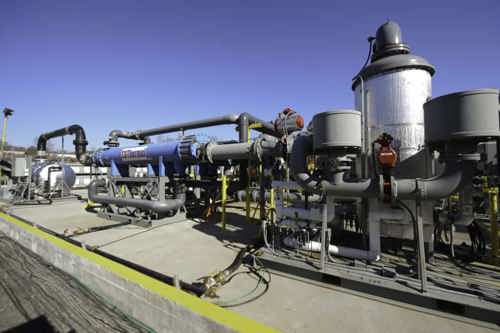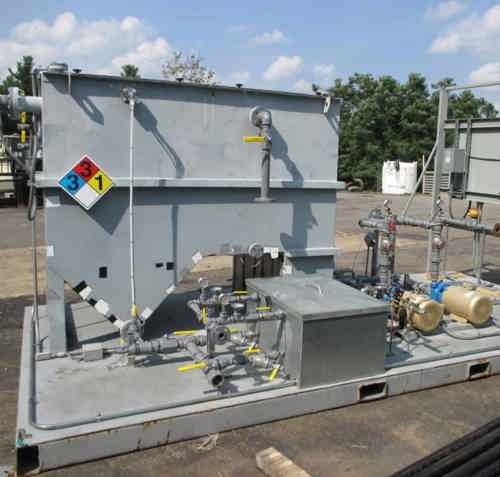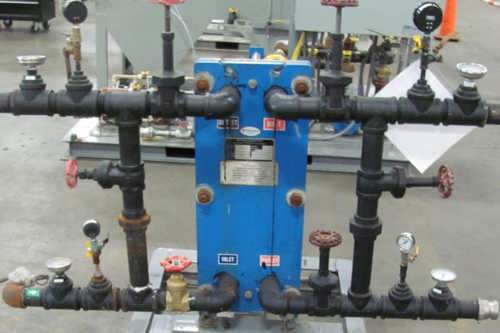Liquid waste is an issue for every thermal remediation project, no matter the heating technology you choose. This means that when you choose a thermal solution for your project, you need to understand how the liquid waste stream is generated, what the requirements are for discharge, and best practices for its handling, treatment, and management.
In this blog post, you’ll learn…
- Where liquid waste comes from
- Steps for treating it
- Options for discharging the liquid waste stream
- The typical key parameters regulatory authorities look at when it comes to permitting the discharge of the treated stream

Where does the liquid come from?
Liquids generated during a thermal remediation project are either pulled directly from the ground via a multi-phase extraction well (MPE) network, or they are generated as condensate in the manifold piping and treatment system. For many systems, it is customary to condense out as much liquid as possible (i.e., remove the steam fraction) to minimize the size of vapor treatment equipment and keep it operating at peak performance.
At some sites, rain and surface water runoff may also need to be collected and sent to the liquid treatment system. This is most common if there is a natural low spot where water pools within the treatment zone and thermal wellfield, or if secondary containment berms around the liquid treatment equipment start to fill up with rainwater or snowmelt. In these instances, sump pumps are normally used to transfer these fluids to the liquid treatment system.
Regardless of the source, liquid streams can be characterized either as an aqueous stream (i.e., water-like) or as a non-aqueous phase liquid (NAPL). The NAPL liquids can be further subdivided into categories that describe if they are either denser than water (DNAPL) or lighter than water (LNAPL).
What are the steps for treating liquid waste streams generated during thermal treatment?
At certain sites, particularly those where heavy hydrocarbons, oils, and tars are present in the subsurface, a substantial amount of NAPL may be pumped directly from the ground. As these fluids tend to be difficult to handle due to their viscosity and propensity to foul equipment, special design and operational considerations need to be utilized for the successful handling and treatment of the liquid waste stream at these sites.
Conversely, at sites containing mostly chlorinated volatile organic carbons (CVOCs) and lighter VOCs—such as benzene, ethylbenzene, toluene, and xylenes (BTEX) —these compounds will be extracted and remain primarily in the gaseous phase, with only trace amounts being present in the condensate if the mass present in the target treatment zone (TTZ) and effluent concentrations are low. At some high mass CVOC/VOC sites, where effluent concentrations are high and near saturation levels, significant amounts of NAPL may be generated during the vapor condensing process. Again, special design and operational considerations need to be utilized for the successful handling and treatment of the liquid waste stream at these types of sites.
How can I discharge the liquid waste stream from thermal treatment?
The heart of any liquid treatment system for a thermal remediation project is the oil/water separator (OWS). It separates the liquid into three phases, aqueous, DNAPL, and LNAPL. OWS units use gravity and density differences between the three phases to achieve separation. The OWS consists of a baffled tank, often with coalescing media to enhance phase separation. DNAPL will sink to the bottom of the tank, the aqueous phase sits above it, and the LNAPL phase, which is generally immiscible, floats on the very top of the tank.

To enhance separation, the incoming liquid is cooled, colder fluids will separate more readily than warm fluids. At most sites, a plate and frame-style heat exchanger is used due to its compactness. For liquid coming straight from the ground, a bag filter is used ahead of this liquid cooler to minimize fouling downstream. This filtered, cooled liquid stream will separate far more easily in the OWS unit. DNAPL can be pumped from the bottom of the OWS to storage tanks based on the liquid level, while LNAPL is skimmed off the top periodically. The remaining aqueous phase is pumped through granular activated carbon (GAC) to remove dissolved contaminants that may be present.

Irrespective of how well these methods remove contaminants from the aqueous effluent stream, it cannot simply be discharged to the nearest waterway or sewer pipe. Each state or local municipality has its own permitting process, including water quality discharge criteria, specifying what is acceptable with respect to liquid temperature, pH, total dissolved solids (TDS)/turbidity, nitrogen chemical oxygen demand (COD), biological oxygen demand (BOD), iron and other metals. Even though treated water may be within regulatory compliance with respect to contaminant concentrations, it may need additional adjustment before it can be discharged, such as pH or temperature adjustment, due to these secondary criteria imposed by local or regional authorities.
In many cases, the treated liquids are temporarily stored in a holding tank so analytical tests can be run at a local laboratory before the liquids are discharged. Once the analytical data is received and reviewed, and it is proven that the aqueous effluent has met the contaminant removal standards and secondary criteria, it can then be discharged. This process can take anywhere from a few days to several weeks, so it is not uncommon to have several holding tanks staged on site until permission to discharge is granted.
In Conclusion
Water chemistry is complex and dealing with the liquid streams generated by in situ thermal remediation systems is site-specific and by no means easy. Good analytical data, including target and non-target contaminants as well as the inorganic chemistry of the water (e.g., geochemistry and speciated metals), helps in evaluating and designing effective and efficient aqueous treatment systems. For some sites with complicated mixtures of contaminants or high iron, manganese, and/or metals in the groundwater, it may be useful to perform lab bench-scale tests to determine the best conditions for the separation of the LNAPL/DNAPL from the aqueous stream, as well as options for adjusting the geochemistry to facilitate removal of unwanted metals and to meet other secondary criteria.
It is good practice to work closely with the local municipality, county, and/or state regulators to ensure the discharge criteria are fully understood and the liquid waste streams are properly treated and managed before they are discharged. Meeting the removal criteria for the organic and inorganic contaminants as well as the secondary criteria standards can have significant impacts on the design and cost of the treatment system, its maintenance, and the frequency and cost of sampling and analysis for compliance with the discharge permit. Working with a thermal remediation practitioner who is experienced in the design, operation, and maintenance of liquid treatment systems and knowledgeable of permitting requirements and the application and approval processes will ensure that your thermal remediation project achieves the desired remedial performance targets while staying on schedule and within budget.
If you still have questions about handling liquid waste streams or just need assistance with your next thermal project, let me know. I’m always happy to help.
02.10.22

